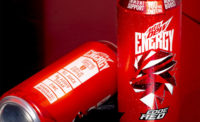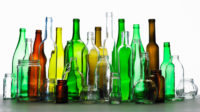Container Demand Spans all Categories
By SARAH THEODORE
Plastic beverage packaging
has been giving other container materials a run for their money for years,
and 2004 was no exception. But metal cans still dominate the soft drink
category, and glass holds nearly half of the beer category and almost all
of the wine and spirits segments, according to Euromonitor
International’s new report “The Market for Packaging in the
USA.”
The largest beverage category, soft drinks, used more
than 84 billion containers last year, with metal cans holding well over
half of the segment at 57.8 billion units. Nearly 26 billion PET bottles
were used for soft drinks, while glass held a scant 736 million units,
saved mainly for premium soft drinks and promotional packages.
Metal cans and glass bottles were neck-and-neck in the
beer category, with almost 28.8 billion cans used to package beer and 28.5
billion glass bottles. While several beer companies have rolled out plastic
packaging, PET bottles mostly have been relegated to sports stadiums and
other glass-free venues, and hold a small portion of the beer market, with
a little more than 208 million containers.
In addition to their use of traditional aluminum cans,
a number of beer companies have taken metal containers in a new direction
during the past year with aluminum bottles. America’s largest brewer,
Anheuser-Busch announced late last year that it would introduce Michelob,
Michelob Light and Anheuser World Select in select bars and restaurants in
aluminum bottles manufactured by Exal USA, Youngstown, Ohio. The sleek new
bottles appeared in Atlanta; Chicago; Las Vegas; Philadelphia; New York;
Pittsburgh; San Diego; Nashville, Tenn.; Washington, D.C.; and some cities
in Florida.
Pittsburgh Brewing Co. rolled out Iron City Premier
Lager in an aluminum bottle manufactured by CCL Container last summer, and
recently followed it with a special limited-edition bottle for I.C. Light.
The I.C. Light bottle celebrates a Pittsburgh-area native, golfer Arnold
Palmer. The 12-ounce bottle features the gold I.C. Light logo on the front
and a picture of Palmer mid-swing on the back.
“In addition to its high performance, aluminum
has many more decorating and shaping options than glass,” says Ed
Martin, vice president of sales and marketing at CCL Container.
“Other beverage manufacturers have utilized the bottle successfully
to distinguish their products in a crowded, competitive market. PBC has
done the same, pairing the bottle’s bold silhouette with its own
signature graphics for an attention-grabbing look.”
CCL Container also supplied aluminum bottles to Molson
for MolsonKick, a new energy-enhanced beer. The new beer made with guarana
will be available in Canada in an aluminum bottle with a brushed finish,
red and white graphics and a matching red, resealable crown. The aluminum
bottles will be available only through bars and clubs in Canada and at
Liquor Control Board of Ontario retail locations.
“The launch of Molson Kick in an aluminum bottle
represents the perfect marriage of an innovative product with an innovative
package,” Martin says.
| U.S. beverage packaging use (Volume — millions of units) | ||
| Carbonated beverages | 2003 | 2004 |
| Metal beverage cans | 57,015.4 | 57,765.4 |
| PET bottles | 25,610.6 | 25,834.8 |
| Glass bottles | 791.7 | 736.4 |
| Total* | 83,507.6 | 84,336.6 |
| Fruit and vegetable juice | 2003 | 2004 |
| Metal beverage cans | 1,606.9 | 1,567.0 |
| PET bottles | 7,848.6 | 8,131.4 |
| HDPE bottles | 546.4 | 537.5 |
| Glass bottles | 4,562.1 | 4,569.1 |
| Gable-top cartons | 1,386.7 | 1,352.7 |
| Brick cartons | 1,113.8 | 1,104.3 |
| Pouches | 3,209.1 | 3,366.8 |
| Total* | 20,757.2 | 21,082.2 |
| Bottled water | 2003 | 2004 |
| Metal cans | 49.7 | 48.9 |
| PET bottles | 14,450.8 | 16,129.5 |
| HDPE bottles | 987.1 | 1,052.1 |
| Glass bottles | 1,406.4 | 1,500.2 |
| Total* | 16,893.8 | 18,730.5 |
| Beer | 2003 | 2004 |
| Metal cans | 28,578.0 | 28,796.8 |
| PET bottles | 178.1 | 208.5 |
| Glass bottles | 27,746.9 | 28,525.6 |
| Total* | 56,569.4 | 57,595.9 |
| Wine | 2003 | 2004 |
| PET bottles | 0.2 | 0.2 |
| Glass bottles | 2,585.3 | 2,660.8 |
| Bag in box | 15.5 | 15.5 |
| Total* | 2,601.0 | 2,676.5 |
| Spirits | 2003 | 2004 |
| PET bottles | 100.3 | 109.2 |
| Glass bottles | 1,647.6 | 1,696.5 |
| Total* | 1,747.9 | 1,805.7 |
| *May include container categories not listed Source: Euromonitor International, Chicago, “The Market for Packaging in the USA” | ||
New in PET
PET also is making inroads into new places, often
replicating the upscale look of glass. Graham Packaging Co., York, Pa.,
earlier this year created a PET bottle for POM Wonderful pomegranate juice,
designed to look like the brand’s award-winning glass bottle. The
bottle features the look of pomegranates stacked on top of one another.
“The bottle was a difficult design for a plastic
food-product container,” says Ashok Sudan, executive vice president
of the global food and beverage business at Graham Packaging. “But
the fruit’s growing popularity and the important health benefits of
this first-ever refrigerated pomegranate juice made the bottle an
attractive challenge.”
Juice is one of the most diverse beverage categories
when it comes to packaging. PET holds the largest share of the segment,
with more than 8 billion units, making a jump from 2003, when it used more
than 7.8 billion container units, according to Euromonitor. Glass is the
second most-popular container type with nearly 4.6 billion units, up
slightly from 2003. Flexible pouches increased during the past year to land
in third place among packaging materials used for juice products. Gable-top
cartons and brick cartons both dropped slightly in use — last year
saw more than 1.3 billion gable-top juice cartons and 1.1 billion brick
cartons.
Among those making changes in juice packaging is The
Coca-Cola Co., which announced recently that has downsized the 1.75-liter
Simply Orange carafe bottle to a new 400-ml. look-alike single-serve
bottle. The new single-serve bottle will be used for Original and Calcium
Simply Orange.
“Our research shows product trial and repeat
purchase of the 1.75-liter Simply Orange are very strong, so we’re
confident that if we get the product into the hands of more consumers in a
convenient package, they’ll respond,” says Grace Teng, Simply
Orange brand manager.
Coca-Cola also has introduced Hi-C Blast in 12-ounce
plastic multipacks to appeal to older children. The company says the
portable plastic bottles are the preferred package among kids.
“Youth and parents told us they liked the new
bottle because its portability and resealability meet the needs of their
active lifestyles, says Brian Powell, senior brand manager at Coca-Cola
North America. “They want the option to take the bottle everywhere
they go and reseal the drink for later.”
Ocean Spray Cranberries also introduced new juice
packaging, with a 3-liter rectangular bottle that can be stored in the
refrigerator door and has a side handle for pouring. The company also
rolled out the Ocean Spray Dispense Pack, a refrigerator multipack that
holds eight 8-ounce bottles.
Tried and true
Glass is by far the leading package for wine and
spirits, with 2.66 billion of the 2.68 billion total wine packages used in
the United States last year, and nearly 1.7 billion of the 1.8 billion
containers used for liquor packaging.
PET also is gaining ground in the spirits category,
increasing from about 100 million containers in 2003 to almost 109 million
last year, and it is expected to reach 122
million units by the end of this year, according to Euromonitor. But PET
wine packaging accounted for less than a million units last year and is
expected to remain in that range in the year to come.
One wine and spirits company that is making the jump
into PET is Korbel Champagne Cellars, Guerneville, Calif., which introduced
a new PET bottle for its Korbel Classic Brandy. The brandy hit the market
earlier this year in a 1.75-liter bottle created by Amcor PET Packaging,
Manchester, Mich.
Creating a more lightweight bottle was one of the most
important goals of the design project. “Lightweighting glass is
almost impossible with a brandy bottle since it is already fairly light
— particularly when you compare it to a champagne bottle,” says
Gary Heck, owner, president and chairman at Korbel.
The new bottle features sloped shoulders and a
pedestal base along with embossed text on the bottom of the bottle. It also
includes the same labeling areas as the glass version of the bottle and a
heat-shrink capsule over the polypropylene screw cap and neck for tamper
evidence.
Another wine company, Three Thieves recently became
the latest wine company to adopt aseptic packaging. Its Bandit Cabernet has
been launched in Tetra Pak’s Tetra Brik Aseptic Package. The package
features the SlimCap plastic screw cap, ring-pull and a standard PullTab.
The caps keep the package airtight until opened, which cannot be achieved
with cork closures.
“This form of packaging is well suited for
protecting wine’s sensitive flavor profiles,” said Jeff Kellar,
vice president of strategic business development at Tetra Pak. “The
lightweight, space-saving Tetra Pak cartons will
better differentiate Three Thieves premium wine brands on the shelf and
make them extremely economical to distribute, store and stock.” BI
Go Fast goes after the sportsman
Go Fast Sports and
Beverage Co., Denver, is using packaging to go after an entirely new
audience with its new special-edition camouflage can. The company teamed
with Realtree, a Columbus, Ga.-based marketer of camouflage patterns in the
hunting industry, to design a can for the hunting and fishing crowd.
The 8.4-ounce package incorporates the Realtree
“Hardwoods HD” camouflage pattern and a gold-tone can, which is
a departure from traditional silver cans. The can will be available in
select hunting outlets and as a special online request order.
Go Fast has tapped bass fisherman Joe Trinko as
spokesman for the product. “Sportsmen are the true architects of this
idea,” he says. “The Go Fast can was created to specifically
address a hunter’s desire to maintain a low profile outdoors, while
enjoying the natural ingredients of a sustained energy kick.”

